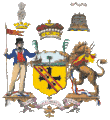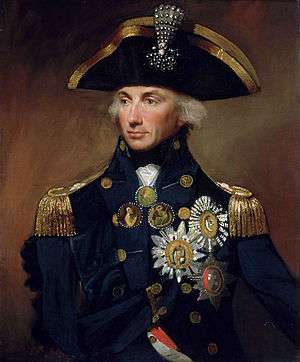Earl Nelson
| Earldom Nelson | |
|---|---|
 Arms: Or, a Cross-Patonce Sable, a Bend Gules, surmounted by another Bend engrailed Or, charged with three Bombs fired proper; on a Chief (of Honourable Augmentation) undulated Argent, Waves of the Sea, from which a Palm Tree issuant, between a disabled Ship on the dexter, and a Battery in ruins on the sinister, all proper. Crests: 1st: On a Naval Crown Or, the Chelenk or Diamond Plume of Triumph, presented to Admiral Horatio, Viscount Nelson by the Grand Signor, Sultan Selim III. 2nd: upon Waves of the Sea the Stern of a Spanish Man-of-War, all proper, thereon inscribed ‘SAN JOSEF’. Supporters: Dexter: a Sailor habited and armed with a Cutlass, with a pair of Pistols in his belt proper, his right hand supporting a Pike proper, thereon hoisted a Commodore’s Flag Gules, and his left holding a Palm Branch proper. Sinister: a Lion reguardant, in his mouth two Broken Flagstaffs, proper, flowing from the one the Spanish Flag Or and Gules, and from the other a French Flag Gules, Argent and Azure, in his dexter paw a Palm Branch proper. | |
| Creation date | 20 November 1805 |
| Monarch | George III |
| First holder | Rev. William Nelson, 1st Earl Nelson |
| Present holder | Simon Nelson, 10th Earl Nelson |
| Heir apparent | Thomas Nelson, Viscount Merton |
| Remainder to | Special remainder – see main text |
| Subsidiary titles |
Viscount Merton Baron Nelson |
| Status | Extant |
| Armorial motto |
Over the 2nd Crest: FAITH AND WORKS Below the shield: PALMAM QUI MERUIT FERAT (Let him wear the palm who has deserved it) |
Earl Nelson, of Trafalgar and of Merton in the County of Surrey, is a title in the Peerage of the United Kingdom. It was created in 1805 for The Rev. William Nelson, an older brother of Vice Admiral The 1st Viscount Nelson, the famous British naval hero, who gained his fame in the wars against Napoléon I. The title still exists, with The Rt. Hon. The 10th Earl Nelson, who has an heir apparent. Trafalgar House (also known as Standlynch Park), the family's ancestral seat in Wiltshire, was sold off in 1948 by The 5th Earl Nelson.
History
The title was created on 20 November 1805 for the Reverend William Nelson, 2nd Baron Nelson, who was a son of the Reverend Edmund Nelson (1722–1802) and an older brother of Horatio Nelson. The Nelson family had been settled in Norfolk for many generations, and the Reverend Edmund Nelson was Rector of Hillborough and of Burnham Thorpe in that county. He married Catherine Suckling, whose maternal grandmother Mary was the sister of both The 1st Earl of Orford and The 1st Baron Walpole of Wolterton. Their fifth but third-surviving son was the renowned naval commander Horatio Nelson.
After defeating the French at the Battle of the Nile in 1798, Horatio Nelson was raised to the Peerage of Great Britain on 6 November 1798 as Baron Nelson, of the Nile, and of Burnham Thorpe in the County of Norfolk, with normal remainder to the heirs male of his body.[1] In 1799, he was created Duke of Bronté (Italian: Duca di Bronte), of the Kingdom of Sicily, by King Ferdinand, which title he was given royal sanction to use in Britain.
After defeating the Danish fleet at the Battle of Copenhagen in April 1801, Nelson was further honoured when he was made Viscount Nelson, of the Nile, and of Burnham Thorpe in the County of Norfolk, with normal remainder to the heirs male of his body, on 22 May 1801.[2] On 18 August of the same year, he was created Baron Nelson, of the Nile, and of Hillborough in the County of Norfolk, with remainder, in default of male issue of his own, to his father and the heirs male of his body, and failing them to the heirs male of the body severally and successively of his sisters Mrs Susannah Bolton and Mrs Catherine Matcham.[3] Both titles were in the Peerage of the United Kingdom.
Nelson was killed at the Battle of Trafalgar on 21 October 1805. Since he had no legitimate children, the barony of 1798 and the viscountcy became extinct upon his death.
He was succeeded in the barony of 1801 according to the special remainder (and also in the dukedom of Bronté) by his older brother the Reverend William Nelson, who became the second Baron. On 20 November 1805, the second Baron was created Viscount Merton, of Trafalgar and of Merton in the County of Surrey, and Earl Nelson, of Trafalgar and of Merton in the County of Surrey, in honour of his late brother and with similar remainder to the barony of 1801.[4] Both titles are in the Peerage of the United Kingdom. The first Earl died without surviving male issue and was succeeded in the dukedom of Bronté by his daughter Charlotte, wife of The 2nd Baron Bridport.
The first Earl was succeeded in the British titles (according to the special remainders) by his nephew Thomas Bolton, the second Earl. He was the eldest son of the aforementioned Susannah Bolton, a sister of the first Earl and the wife of Thomas Bolton of Wells in Norfolk. The second Earl assumed the surname of Nelson upon succeeding to the peerages. He only held the titles for eight months and on his early death, the titles passed to his eldest son, the third Earl. He was succeeded by his third but eldest surviving son, the fourth Earl. He never married and on his death in 1947, the titles passed to his eighty-seven-year-old younger brother, the fifth Earl. He was succeeded by his eldest son, the sixth Earl, who was a lecturer in astronomy and anthropology. Two of his younger brothers, the seventh and eighth Earls, both succeeded in the titles.
As of 2017, the peerages are held by Simon John Horatio Nelson, 10th Earl Nelson (born 1971), a great-grandson of the fifth Earl. He succeeded in 2009 and is the eldest son of Peter John Horatio Nelson, the ninth Earl.
Two other members of the family also had distinguished naval careers. The Hon. Maurice Horatio Nelson (1832–1914), third son of the second Earl, was a Rear-Admiral in the Royal Navy. His eldest son, Maurice Henry Horatio Nelson (1864–1942), was a Captain in the Royal Navy.
Armorial bearings
Arms were originally granted to Horatio Nelson and confirmed on 20 October 1797. The original Nelson family arms were altered to accommodate his naval victories.[5] After the Battle of Cape St Vincent in 1797, Nelson was dubbed a Knight of the Bath and granted heraldic supporters of a sailor and a lion.
In honour of the Battle of the Nile in 1798, the Crown granted him an augmentation of arms that may be blazoned "on a chief wavy Argent a palm tree between a disabled ship and a ruinous battery all issuant from waves of the sea all proper", the motto Palmam qui meruit ferat (Latin for "let him who has earned it, bear the palm"), and added to his supporters a palm branch in the hand of the sailor and in the paw of the lion, and a "tri-colored flag and staff in the mouth of the latter".[6] After his death, his older brother William Nelson was granted the augmentation "on a fess wavy overall Azure the word TRAFALGAR Or".[7]

 Armorial achievement of Viscount Nelson before the Battle of Trafalgar[5]
Armorial achievement of Viscount Nelson before the Battle of Trafalgar[5]_COA.svg.png) Arms of Viscount Nelson and the later Earls Nelson (without augmentations)
Arms of Viscount Nelson and the later Earls Nelson (without augmentations)
Baron Nelson, First creation (1798)
- Horatio Nelson, 1st Viscount Nelson, 1st Baron Nelson (1758–1805) (extinct on his death; created Viscount Nelson in 1801)
Viscount Nelson (1801)
- Horatio Nelson, 1st Viscount Nelson, 1st Baron Nelson (1758–1805) (extinct on his death)
Baron Nelson, Second creation (1801)
- Horatio Nelson, 1st Viscount Nelson, 1st Baron Nelson (1758–1805)
- William Nelson, 2nd Baron Nelson (1757–1835) (created Earl Nelson in 1805). Elder brother of the aforementioned.
Earls Nelson (1805)
- William Nelson, 1st Earl Nelson (1757–1835)
- Thomas Nelson, 2nd Earl Nelson (1786–1835)
- Horatio Nelson, 3rd Earl Nelson (1823–1913)
- Thomas Horatio Nelson, 4th Earl Nelson (1857–1947)
- Edward Agar Horatio Nelson, 5th Earl Nelson (1860–1951)
- Albert Francis Joseph Horatio Nelson, 6th Earl Nelson (1890–1957)
- Henry Edward Joseph Horatio Nelson, 7th Earl Nelson (1894–1972)
- George Joseph Horatio Nelson, 8th Earl Nelson (1905–1981)
- Peter John Horatio Nelson, 9th Earl Nelson (1941–2009)
- Simon John Horatio Nelson, 10th Earl Nelson (born 1971)
The heir apparent is the present holder's only son, Thomas John Horatio Nelson, Viscount Merton (born 2010).
See also
Notes
- ↑ "No. 15067". The London Gazette. 6 October 1798. p. 931.
- ↑ "No. 15366". The London Gazette. 19 May 1801. p. 549.
- ↑ "No. 15393". The London Gazette. 1 August 1801. p. 948.
- ↑ "No. 15859". The London Gazette. 5 November 1805. p. 1376.
- 1 2 3 "The Nelson Arms". The Heraldry Society. Retrieved 7 October 2017.
- ↑ Harrison, James (2007) [1806]. The Life of the Right Honourable Horatio Lord Viscount Nelson. 1. BiblioBazaar, LLC. p. 266. ISBN 978-1-4346-0663-1.
- ↑ Foster, Joseph (1882). The peerage baronetage and knightage, of the British Empire for 1882 with the Orders of Knighthood. Westminster: Nichols and Sons. p. 494.
References
- Kidd, Charles, Williamson, David (editors). Debrett's Peerage and Baronetage (1990 edition). New York: St Martin's Press, 1990,
- Lundy, Darryl. "FAQ". The Peerage.
- Leigh Rayment's Peerage Pages
